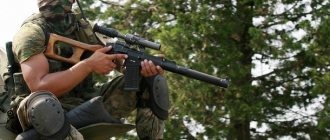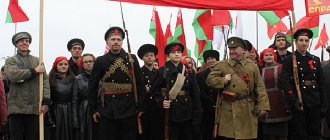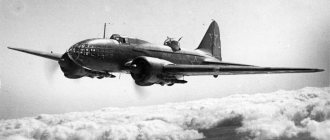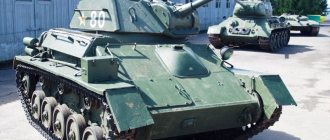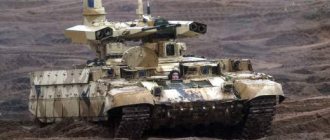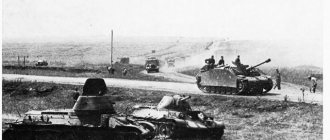Dmitry Lavrinenko - Soviet tank ace
Dmitry Lavrinenko , who destroyed fifty-two tanks during the battles with the fascist occupiers, is considered the most successful Soviet tanker of the Second World War. What makes his feat more outstanding is the fact that this serviceman died in 1941, and participated directly in hostilities for only two and a half months. Senior Lieutenant Lavrinenko, according to Marshal E.V. Katukov is the best tanker of the Second World War, since Wehrmacht tank aces took part in battles until 1945. For outstanding military service, the command nominated Dmitry Lavrinenko to the Hero Star. However, he was awarded the Order of Lenin. A year before the collapse of the USSR, the hero’s feat was appreciated, and in 1990, by the Decree of the Supreme Presidium of the USSR, Dmitry Fedorovich Lavrinenko was posthumously awarded the title of Hero of the Soviet Union.
Before military service
The future tank ace was born on October 14, 1914 in the village of Besstrashnaya (Kuban) into a Cossack family. His father, having gone through the First World War, took the side of the Soviet regime in the Civil War and died during battles with the White Cossacks. Dmitry was raised by his mother, who held the position of chairman of the village council in the Armavir region. In 1931, Dmitry Lavrinenko graduated from school, a little later teaching courses in Armavir. He was sent as a teacher to a village in the Armavir region. At that time, Dmitry was only 17 years old, but then he already enjoyed authority among his colleagues and students. On his initiative, sports sections began to function at the school. From 1933 to 1934 he worked as a statistician at a state farm, and later as a cashier at a savings bank in a village near the regional center.
Military service until 1941
In 1934, Dmitry Lavrinenko, two years before conscription, volunteered for the Red Army. He was sent to serve in the cavalry. In 1935 he became a cadet at the Ulyanovsk Red Banner Armored School. In May 1938 he graduated with the rank of junior lieutenant. Dmitry’s classmates spoke about his thirst for knowledge, as well as his ability to accurately shoot from all types of weapons, for which he received the nickname “Sniper’s Eye.”
In 1939, junior lieutenant Lavrinenko took part in hostilities against Poland, in the so-called liberation campaign. In 1940 he became a participant in the military conflict between the USSR and Romania over Bessarabia.
* During a military campaign against Romania in the city of Stanislav (today Ivano-Frankivsk, Ukraine) Lavrinenko D.F. meets his future wife at an evening.
There are no impossible tasks
After the incident that happened on the outskirts of Serpukhov, Lavrinenko returned to his tank brigade, which now occupied positions in the Volokolamsk direction, next to Panfilov’s and Dovator’s .
Here Lavrinenko’s talent showed itself with all its might. It seemed that there were no impossible tasks for him. On November 17, a column of German tanks broke through into the rear of the Soviet troops. Lavrinenko, in addition to his own car, had only a BT-7 light tank. Deciding that he was no help to him, the lieutenant sent the BT to headquarters with a report on the situation, and he himself took a position on the road where the Germans were about to appear.
There were practically no shelters on the ground, but a few days before, Lavrinenko and his crew whitewashed their T-34. The car literally blended in with the snow fields around it, which served as an excellent camouflage.
Article on the topic
Twenty-two against one. How tanker Kolobanov humiliated the Third Reich
Soon eight German tanks reached Lavrinenko’s position. They did not notice the white "thirty-four", which became the decisive factor in the battle. Soviet tank crews shot the leading and trailing tanks, then walked along the column. As a result, having destroyed three medium and three light tanks, the T-34 detained the enemy, and itself successfully escaped pursuit.
On November 18, 1941, Dmitry Lavrinenko took part in repelling a German attack on the command post of General Panfilov’s division. The lieutenant became a direct witness to the death of the division commander. It seems that this was the first time that the cold-blooded tanker flew into a rage. In the oncoming battle, Lavrinenko’s crew destroyed seven enemy tanks. Without remembering himself, the officer jumped out of the car with a pistol and rushed to pursue the fleeing Germans from the damaged cars.
Military service during the Great Patriotic War
When the war began, Dmitry Lavrinenko served as a platoon commander of the 15th TD, which was stationed in Western Ukraine in Stanislav. On July 2, an order was received to withdraw units of the 15th TD. During the withdrawal of troops to the Derazhnya station, the platoon commander refused to blow up his faulty tank (a huge amount of equipment during the march failed, was abandoned and destroyed so that it would not fall to the enemy), which was done in order to clear the road for the troops. This also led to the fact that Lieutenant Lavrinenko D.F. did not take part in the battles. Only after the division was sent for reorganization, the platoon commander gave the vehicle for repair. As for the 15th Tank Division itself, it was destroyed in the Uman cauldron.
* Tankers left without their equipment were often used as infantry during the first months of the war.
Soon, in the Stalingrad region, from the remnants of the 15th and 20th tank divisions, a tank brigade began to be formed under the command of Colonel E.V. Katukov, the future marshal of the armored forces. The 4th TB was armed with brand new KV and T-34, produced in Stalingrad at the tractor plant. Dmitry Lavrinenko , who was awarded a brand new thirty-four, was appointed platoon commander. On September 28, the 4th TB was transferred to the Moscow direction in the area of the station. Cuban. The formation was equipped with repaired BT tanks. On October 3, the tank brigade was finally formed and subordinated to General D.D. Lelyushenko, commander of the 1st Special Guards Rifle Corps.
First battles, senior lieutenant Lavrinenko D.F. As part of the 4th TB, he was accepted near Mtsensk in October, when Guderian’s 2nd Panzer Group confronted Soviet troops. On October 6, the enemy attacked the positions of a tank brigade in the area of the village of Pervy Voin with tanks and motorized infantry. After the anti-tank guns were destroyed, German tanks managed to break through to the infantry positions, which they began to shoot and crush. The brigade commander sent a group of four T-34 tanks under the command of Senior Lieutenant D.F. Lavrinenko to eliminate the breakthrough. Using the terrain and attacking enemy tanks from different directions, the Soviet tank crews managed to inflict serious damage on the advancing Germans (15 tanks were destroyed). The crew of the thirty-four Lavrinenko D.F. destroyed four tanks. Despite the fact that the enemy’s advance was suspended, Colonel Katukov gave the order to withdraw from the positions. The surviving infantrymen were placed on the armor, and in this order the tanks of the 4th TB withdrew. By October 11, the ace already had 7 enemy vehicles, 2 infantry platoons and one anti-tank gun.
After the battles for Mtsensk, the 4th Tank Brigade was transferred to the Volokolamsk direction. October 16 Colonel Katukov E.V. At the request of the command of the 50th Army, Lavrinenko allocated thirty-four to guard the headquarters. The brigade arrived at Chismena station on September 19. However, the vehicle, which was delayed for only a few hours by the headquarters of the 50th Army, arrived only in the afternoon of October 20. The battalion commissar immediately demanded an explanation from the crew commander. However, Dmitry Lavrinenko handed over a paper signed by the commandant of Serpukhov, brigade commander Firsov, expressing gratitude to the crew for their assistance in the defense of the city. The fact is that the tank was unable to catch up with the brigade along the clogged road and stopped for a while in Serpukhov. The Germans, having broken through the defenses, moved up to one battalion in cars with guns and motorcycles to Serpukhov. Soviet troops did not have time to approach to repel the breakthrough. Therefore, the Firsovs decided to use the only tank for defense, the crew of which was located in the city’s hair salon. Lavrinenko attacked the German column using his tactics of surprise ambushes. The enemy was completely defeated. In addition, a headquarters vehicle was captured and taken to the headquarters of the 4th Tank Brigade. The documents were so important that they were immediately transferred to the corps, and from there to Moscow.
Barber shop tank
One day, the commandant of the city of Serpukhov, Pavel Firsov, received a call from a frightened telephone operator from the village of Vysokinichi. She said that a German column passed through the village without stopping.
A little earlier, the 17th Rifle Division was forced to retreat to a new line of defense, which is why the road to Serpukhov was open.
The Nazis sent a large reconnaissance detachment to the city - up to a battalion of infantry and motorcyclists, three trucks with guns and a headquarters bus.
Article on the topic
Tiger hunters. The amazing fates of female tankers
It was absolutely impossible to let them into Serpukhov. But the commandant had only a fighter squad at hand, made up of very young boys and old men. How can you stop a column with cannons with such forces?
And then Firsov was informed that a Soviet tank had been seen in Serpukhov. The T-34 was allegedly parked outside a local hairdresser's. The commandant sent a Red Army soldier to check the information, not particularly hoping for success. But soon the crew commander was already standing in front of him. The tankers moved to the concentration area under their own power, which was not easy due to columns of refugees clogging the roads. Having reached Serpukhov, the crew decided to take advantage of the moment and get themselves in order at the hairdresser.
Firsov outlined the situation to the tank lieutenant. He, having listened, replied: “The tank is filled, there is ammunition, we will help!”
Death
Dmitry Lavrinenko continued to smash the enemy near Moscow. On December 5, the command nominated him for the title of Hero of the Soviet Union (by that time he had knocked out 37 tanks). The best Soviet tankman at that time was not only an excellent sniper, but also masterfully used the terrain, as well as the tactics of a surprise ambush attack, which caused the enemy to feel a massive attack and panic. For example, in the battle for the village of Lystsevo on November 17, his T-34 knocked out seven out of eight tanks in 8 minutes: only one managed to escape: the gun of Lavrinenko’s tank jammed.
By December 18, Guard Senior Lieutenant Lavrinenko D.F. commanded a company of the 1st GTB. During the offensive in the battle for the village of Goryuny, the tank ace destroyed his 52nd German tank. Soviet troops managed to knock out the enemy, who then rained powerful artillery fire on the populated area. Dmitry Lavrinenko was killed by a small shell fragment that hit him in the temple. He was buried on the side of the road at the scene of his death. On December 12 he was posthumously awarded the Order of Lenin. In 1967 he was reburied in the village of Denkovo in a mass grave.
* Dmitry Lavrinenko’s wife, Nina, died in 1942 at the Armavir station during a bombing, when she was traveling to the front in a train as a nurse.
Bus as a trophy
The German column moved towards Serpukhov without sending reconnaissance forward. The Nazis were confident that Russian resistance had been completely broken. They realized their mistake only when one of the vehicles was hit by a tank shell. The T-34, camouflaged on the edge of the forest, shot at the Germans from a distance of several hundred meters. Then the tank jumped out of its cover and crushed the last surviving enemy cannon. The demoralized fascists were finished off by fighters from the extermination squad.
Article on the topic
A fortress named "KV". How tanker Konovalov stopped the German army
The tank crews had no time to listen to the commandant’s gratitude. Nobody canceled the main task, and they hurried on, taking as a trophy the German staff bus that somehow miraculously survived the defeat of the column. This trophy helped the lieutenant justify his lateness. The documents and maps found in it were handed over to the command.
Serpukhov's savior's name was Dmitry Lavrinenko . Over the course of several months of heavy fighting in 1941, he became the most productive Soviet tanker. No one managed to surpass his figure - 52 destroyed enemy tanks.
The reward has found a hero
Marshal Katukov, General Lelyushenko, and many prominent figures of Kuban tried to get Dmitry Lavrinenko posthumously awarded the Gold Star. However, not wanting the relatives of the tank ace to claim privileges, until 1990 the USSR military department refused to nominate him for the award. And only on May 5, 1990, Dmitry Lavrinenko, almost 50 years after his death, was awarded the title of Hero of the Soviet Union.
* Disputes still continue about the identity of D.F. Lavrinenko. Many, making a name for themselves on cheap sensations, prove that the best tanker of the Second World War is the fruit of Soviet propaganda.


